Hull WwTW – Project Update (2021)
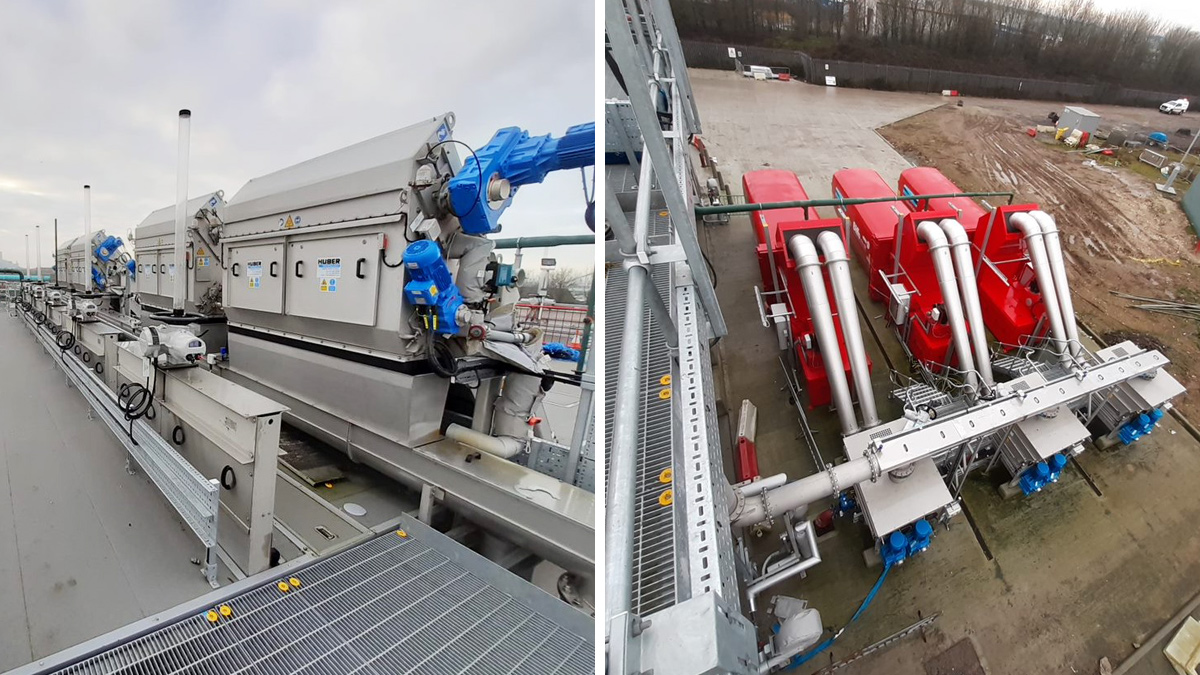
Screens and handling units - Courtesy of MMB
Located in Saltend, Yorkshire Water’s Hull WwTW provides sewage treatment for a population equivalent of over 1 million people, covering an area from the west of Hull to Hedon in the east. This case study follows on from an initial paper in 2020 and details the progress of the new inlet works and the refurbishment of the sludge treatment facility, ensuring that the drivers for the project are achieved.
Project drivers
The primary drivers for the upgrade were:
- Improving preliminary treatment – dedicated flow to full treatment inlet works.
- Improved sludge production for composting – Full mechanical and electrical refurbishment of the digestion process, including new centrifuge dewatering facility.
- New liquid and cake import facilities.
To meet these drivers, a £34m scheme commenced in September 2019 which required the detailed design and construction of a new elevated inlet works for the preliminary treatment of raw sewage flow to full treatment of 2000 l/s as well as the refurbishment of the existing sludge treatment facility.
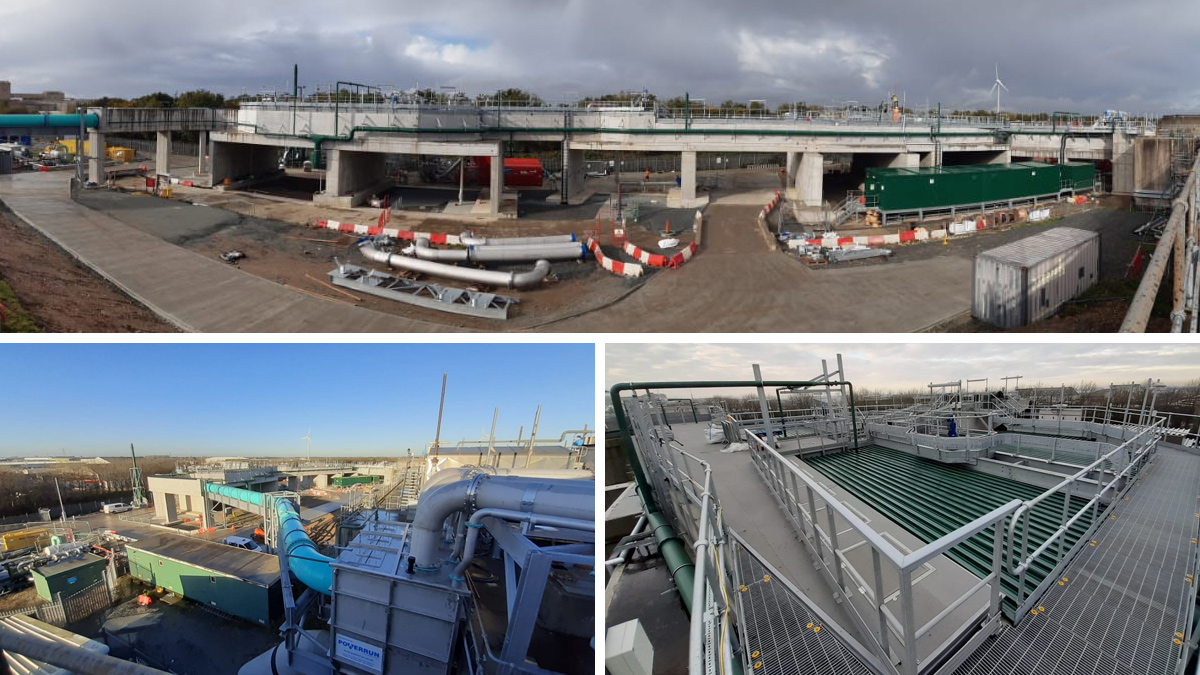
The new elevated inlet works and detritors (bottom right) – Courtesy of MMB
Elevated inlet works: Progress March 2021
The new dedicated full to flow treatment (FFT) inlet works comprised an elevated coarse screens, grit removal and fine screens, an inlet works return liquors pumping station and a new inlet works odour control plant.
To eliminate the need for high level temporary works and speed construction, the decision was taken early on to incorporate the temporary works into the permanent works design.
The raised inlet works was a combination of precast and in situ reinforced concrete elements. Prestressed bridge beams with an in situ topping were used to span between in situ support walls to create a level deck over 5m above ground level on which to construct the FFT channel walls. The FFT channel walls were in turn, a unique series of precast walls. Sockets were cast into the outer precast bridge beams to create virtually instant edge protection, allowing for safer working conditions whilst working at height to construct the channels, with shorter construction times. The bridge span lengths between the in situ walls were limited by the amount of pre-camber the beams had from pre-stressing the beams. Too much camber would have resulted in excessive deflection under increasing loads which could have potentially caused cracking of the precast FFT channel wall joints.
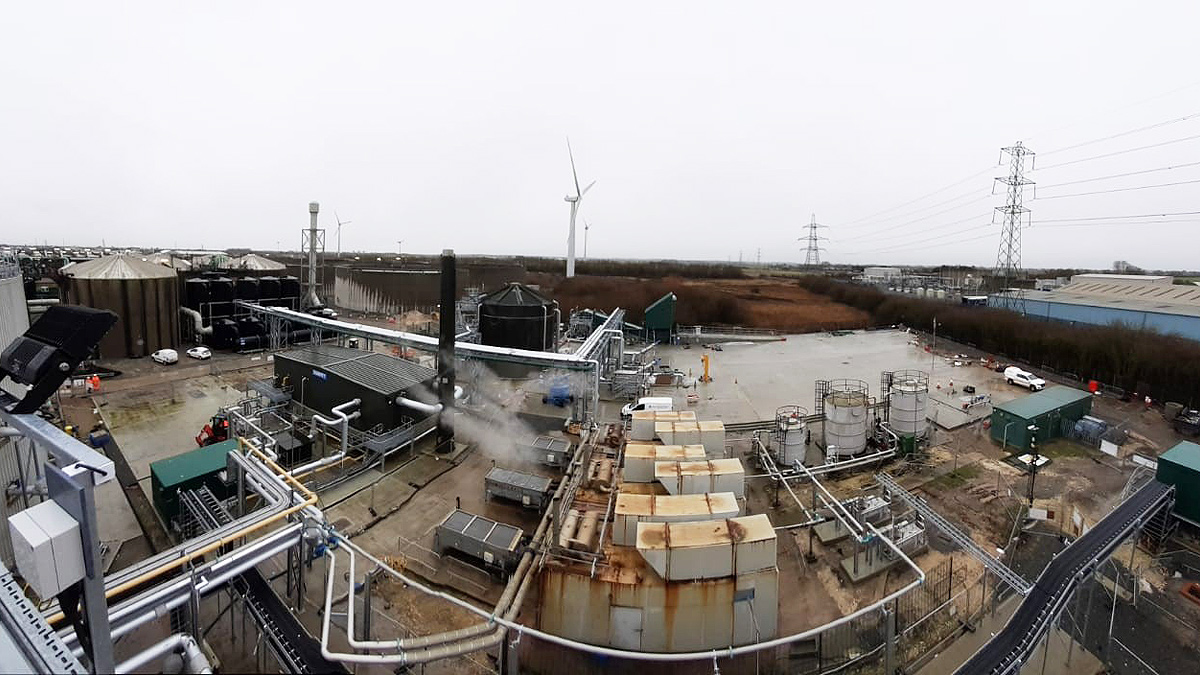
The boilers, antifoam dosing, CHP integration and liquid and cake imports facilities – Courtesy of MMB
Sludge treatment facility refurbishment: Progress March 2021
The sludge treatment facility (STF) refurbishment was undertaken whilst maintaining full treatment capacity. The scope of work included:
- New liquid and cake sludge imports facility.
- Refurbishment of four digesters and full mechanical and electrical renewal of digester sludge feed pumps, digester mixer pumps, heat exchangers and recirculation pumps.
- New gas system, including biogas holders and flare.
- New hot water system including boiler and integration with existing combined heat and power (CHP) systems.
- New sludge dewatering centrifuges including polyelectrolyte and lime dosing.
- Ancillary high voltage supplies with improved ring main switching and motor control centres.
The STF refurbishment required a phased approach to project delivery, further restricted by high seasonal summer loading and high winter energy demand. The Commissioning Plan detailed the phased approach and strategy taken forward; this was based upon process modelling outputs to highlight the variable digester loading, gas production, energy (heat) demand and energy (power) generation.
The strategy and phasing plans were developed early within the project lifecycle to incorporate all stakeholder needs and ensure a collaborative approach to process safety, process risk and manage the numerous interfaces of two live digestion processes in operation at the same time.
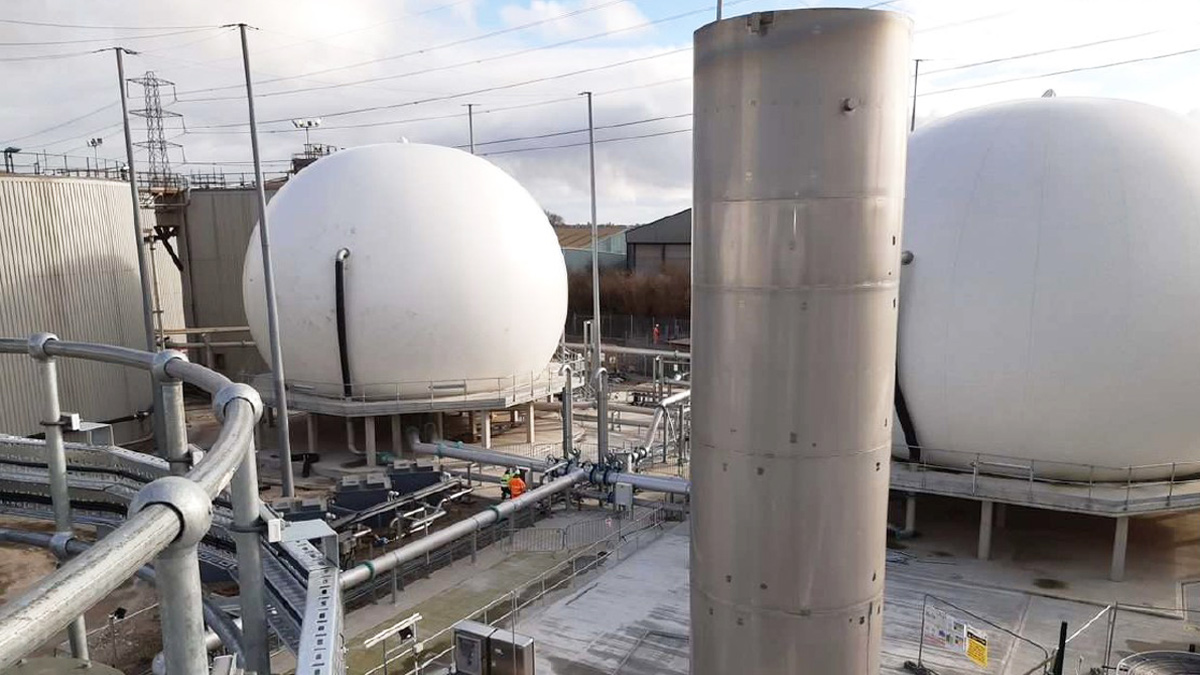
New gas holders and flare system and the new dewatering plant to rear – Courtesy of MMB
Sludge treatment facility commissioning planning
The site required four operational digesters in summer months (peak season). While this could be reduced to three digesters outside of the peak season, a decision was taken not to introduce unnecessary process risk.
As the biogas systems could not be integrated, the refurbished digesters were isolated from the existing system once back online, running both existing and refurbished sites in parallel, with a temporary interface between the systems during the transitional phase. This involved significant planning around temporary works and isolation procedures. This needed to be flexible to change due to the risks which working on or near and existing system can bring. This has been hugely successful throughout the scheme and culminated with the final parts of existing system being successfully brought offline in early 2021.
Commissioning implementation
In February 2020, with two digesters offline and under refurbishment, an issue occurred with one of the four non-operational digesters and this was isolated and taken offline to repair. While the cautious approach maintained three operational digesters, the peak season was approaching and refurbishment of the one new digester became urgent to maintain capability of the plant through peak season.
The collaborative nature of the planning allowed for a swift change of plans to meet the new scenario. This was further complicated in March 2020 when Covid-19 lockdown restrictions were introduced. The entire supply chain had to adopt new procedures to deal with the impact of the global pandemic, whilst maintaining full operational capacity to bring the refurbished digesters and new biogas systems on-line ahead of peak season. Notably, the entire boiler system still had to complete manufacture, be inspected and installed on site and finally commissioned. Modular offsite build of this component was crucial to the ability to achieve this while under lockdown controls.
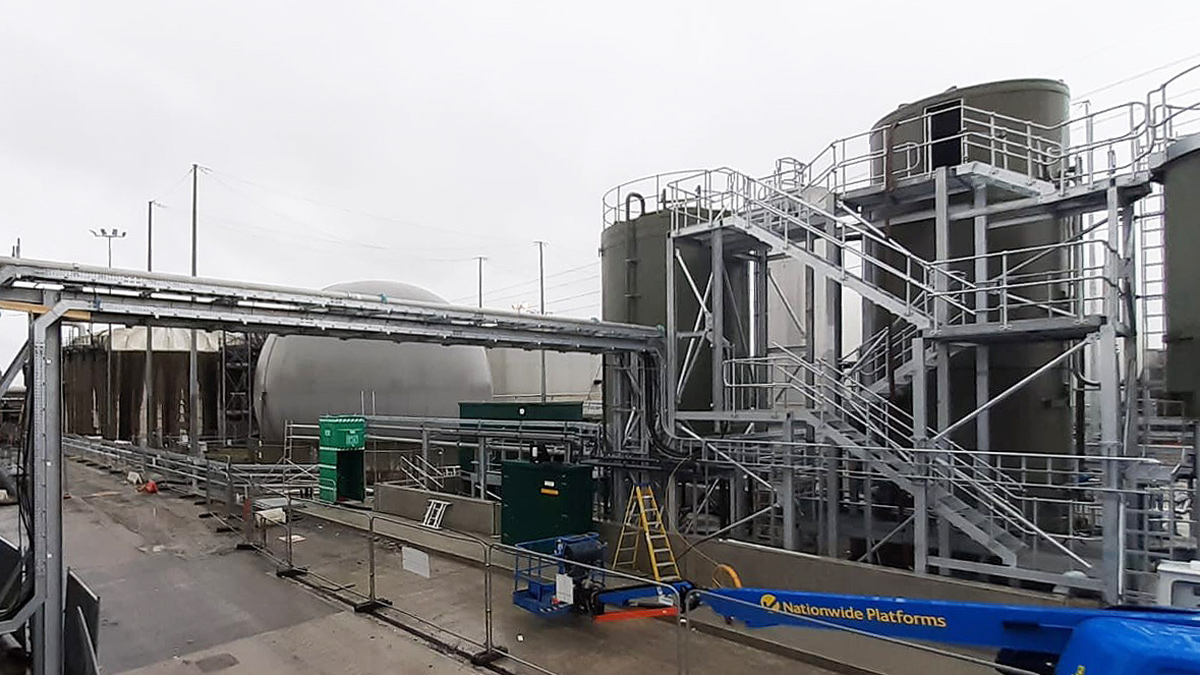
New dewatering plant, centrifuges, liquid lime and polyelectrolyte dosing plant – Courtesy of MMB
The site works to the STF never stopped throughout the pandemic and in early June 2020, the first two digesters were seeded and brought online, with biogas used to supply the new boilers and hot water system. Once the new digesters were brought online, the faulty digester (already under repair) and the fourth digester were handed over for refurbishment.
Feed sludge was controlled between to maintain throughput to the refurbished digesters whilst maximising feed to existing digesters to maximise biogas generation supply to the CHPs.
CHP changeover & commissioning completion
Following peak season in Autumn 2020, the biogas to the CHPs was brought onto the new system in advance of bringing the third refurbished digester online. Once the third refurbished digester was seeded, the new hot water system was tied into the CHPs, and the fifth digester was isolated. The final digester was maintained in service to hold seed stock for the final digester to be brought online at the start of 2021.
With the fourth digester seeded in February 2021, the final digester was taken offline allowing the full existing gas system to be purged and removed in advanced of decommissioning works.
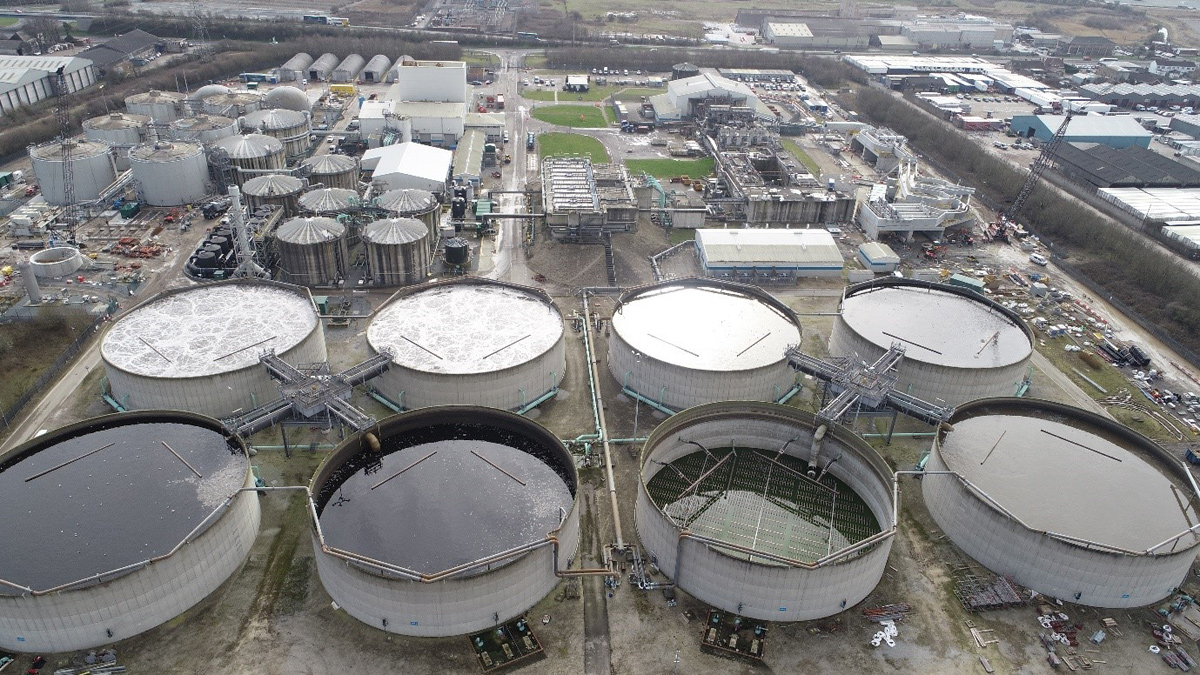
View of Hull WwTW – Courtesy of MMB
Hull WwTW: Inlet works & STF refurbishment supply chain – key participants
- Principal contractor: Mott MacDonald Bentley (MMB)
- Process designer: Mott MacDonald
- Commissioning lead (imports and digestion/energy): Leada Engineering
- Piling: Keller Ltd
- FRC: Overhall Contractors Ltd
- Demolition: Ron Hull Demolition Ltd
- Digester cleaning: GTS Nitrogen Services Ltd
- Ground stabilisation: DNS (Midlands) Ltd
- Precast concrete inlet structure: Shay Murtagh Precast
- Tank construction: Goodwin Tanks Ltd
- Mechanical installation: Alpha Plus Ltd
- LV: Circle Control & Design Systems
- HV: Freedom
- HV: Schneider Electric Ltd
- Boiler: Dunphy Combustion Ltd
- Cake imports: CTM Systems Ltd
- Centrifuges: Alfa Laval Ltd
- Feed pumps: EMS Industries Ltd
- Shoring/temporary works: National Trench Safety UK
- Large scale blending (back mixing) PC pumps (Hull): SEEPEX UK Ltd
- Flare stack: Flare Products Ltd
- Gas boosters: Utile Engineering Co Ltd
- Gas holders and heat exchangers: Biogas Products Ltd
- Grit removal: Tuke & Bell Ltd
- Kiosks: NPS GRP Ltd
- Lime and ferric dosing: Ross-shire Engineering Ltd
- MCC panels: Total Automation & Power
- Metalwork: Galliford Try Fabrications
- Mixer pumps: Hidrostal Ltd
- Odour covers: Air-Water Treatments Ltd
- Odour control: Odour Services International Ltd
- Flow control: AFFCO Flow Control (UK) Ltd
- Penstocks and stop logs: IQ Engineers Ltd
- Polymer dosing: Northern Pump Suppliers Ltd
- Screens: Fine, coarse and sludge: Huber Technology
- Skip compactors: Challenger Handling Ltd
- Sludge pumps: Xylem Water Solutions UK Ltd
Project progress
The refurbished digesters and sludge treatment facility plant were brought online early 2021, with sludge import, cake re-wetting and dewatering operations scheduled for completion in Spring 2021. The inlet works were completed in 2020 with commissioning commencing in Spring 2021.















